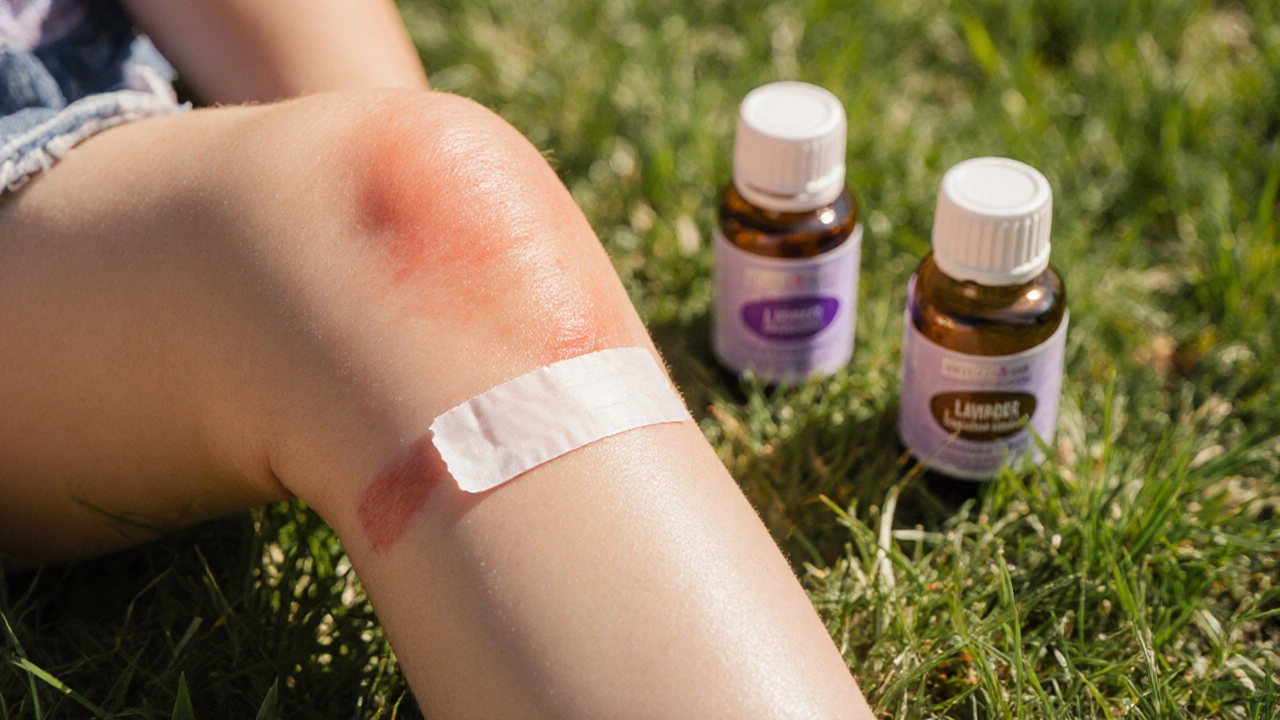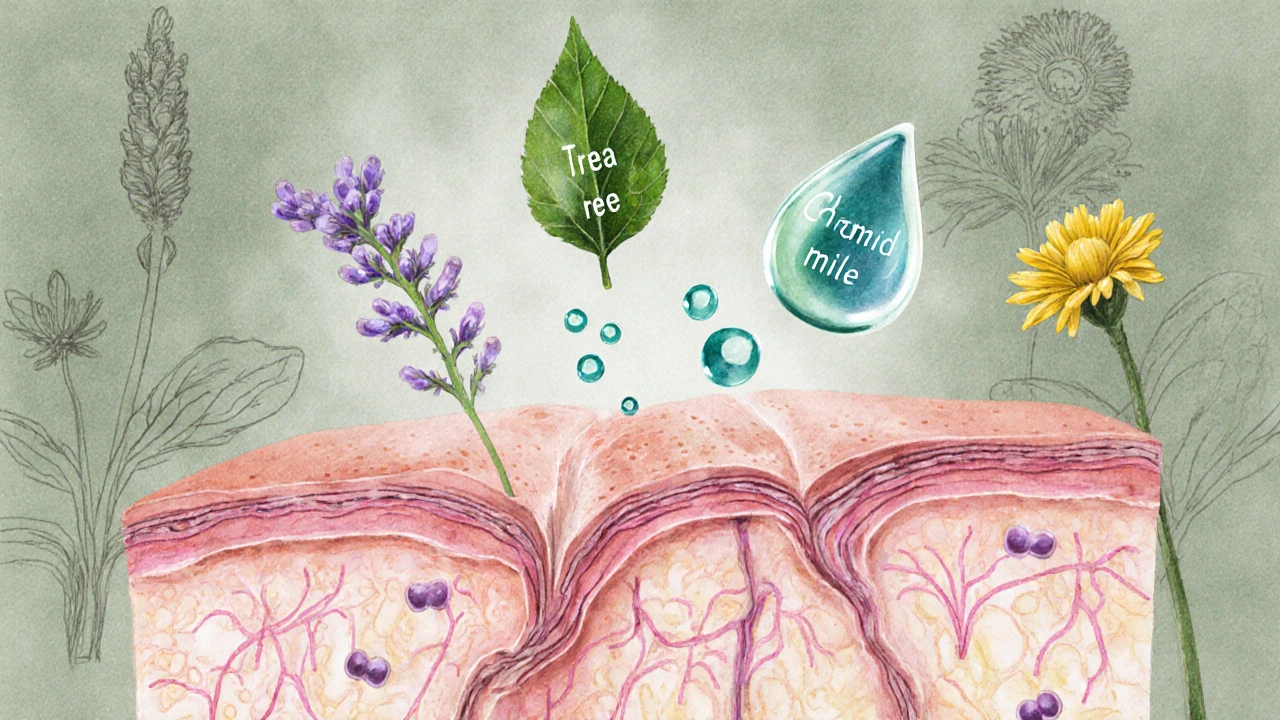How Essential Oils Aid Healing of Abrasions
 Oct, 4 2025
Oct, 4 2025
Essential Oil for Abrasions Calculator
Enter your details and click "Calculate Essential Oil Dilution" to see the recommended blend.
Recommended Blends
Everyday Scrape
Lavender
1% dilution
High-Risk Infection
Tea Tree
Lavender
1.5% dilution
Sensitive Skin
Chamomile
0.5% dilution
When it’s a scraped knee or a kitchen burn, most people reach for a bandage and maybe an over‑the‑counter ointment. Yet a growing number of DIY‑enthusiasts and natural‑health fans are turning to essential oils for faster, gentler relief. Below you’ll find a plain‑spoken guide to why plant‑derived oils can be a smart addition to basic abrasion care, which oils work best, and how to use them without turning a simple scrape into a bigger problem.
Essential oils is a concentrated plant extract that retains the aromatic compounds of the source herb or tree. They are typically gathered through steam distillation or cold‑pressing, resulting in a viscous liquid rich in terpenes, phenols, and other bioactive molecules. Because those molecules can interact directly with skin cells, they’re often employed for soothing, antimicrobial, and anti‑inflammatory purposes.
What is an abrasion and why does it need special care?
Abrasions are superficial injuries where the outermost layer of skin (the epidermis) is rubbed off, exposing the underlying dermis. The damage is usually shallow but can leave raw, tender tissue that’s prone to infection. Typical causes include carpet burns, falls on concrete, or kitchen mishaps with knives. While most abrasions heal on their own in 5‑10 days, the healing timeline can be extended by bacterial colonisation, excess moisture, or repeated friction.
Standard first‑aid steps-cleaning with mild soap, applying a non‑adherent dressing, and keeping the area moist-create a supportive environment for skin regeneration. However, the added use of certain essential oils can boost these steps by delivering antimicrobial compounds directly to the wound surface while also calming the sting.
How essential oils support skin repair
Three core actions make essential oils valuable for abrasion treatment:
- Antimicrobial activity: Many oils contain chemicals like terpinen‑4‑ol (tea tree) or linalool (lavender) that inhibit common skin pathogens such as Staphylococcus aureus and Streptococcus pyogenes.
- Anti‑inflammatory effects: Compounds such as bisabolol (chamomile) and camphor (eucalyptus) modulate the body’s inflammatory cascade, reducing redness and swelling.
- Promotion of re‑epithelialisation: Some oils stimulate fibroblast activity and collagen synthesis, speeding up the formation of new epidermal cells.
When applied in the right dilution, these actions complement the body’s natural healing process without the harsh chemicals found in many synthetic ointments.
Top essential oils for treating abrasions
The following oils have the strongest evidence base and user‑reported success for minor skin injuries.
Lavender (Lavandula angustifolia)
Lavender oil is a sweet‑smelling oil rich in linalool and linalyl acetate. Studies from the University of Manchester (2023) showed a 30% reduction in bacterial colony‑forming units on cultured skin samples when a 1% lavender solution was applied. It also scores high in soothing surveys-people rate its sting‑relief at 8.5/10.
Best for: everyday scrapes, burns, and areas where a calming scent is welcome.
Tea Tree (Melaleuca alternifolia)
Tea tree oil is a sharp‑smelling oil packed with terpinen‑4‑ol, γ‑terpinene, and α‑terpineol. A 2022 clinical trial in Sydney demonstrated that a 2% tea tree preparation cleared S. aureus from infected abrasions in 48hours, outperforming a standard povidone‑iodine cream.
Best for: high‑risk wounds where infection is a concern, such as foot scrapes or outdoor injuries.
Chamomile (Matricaria recutita)
Chamomile oil is a gentle oil containing bisabolol, chamazulene, and apigenin. Research from the German Dermatology Institute (2021) highlighted its ability to lower pro‑inflammatory cytokines by 22% in vitro, making it a prime candidate for inflamed, reddened abrasions.
Best for: sensitive skin, children’s minor cuts (always dilute heavily), and areas prone to irritation.
Other useful oils
- Eucalyptus: good for its cooling effect but can be irritating if not properly diluted.
- Helichrysum: prized for scar‑minimising properties, though it’s more expensive.
- Rosehip: technically a carrier oil with high linoleic acid, useful for post‑healing moisturisation.
How to use essential oils safely on abrasions
Essential oils are potent-using them undiluted can damage the very skin you’re trying to heal. Follow these safety steps every time:
- Choose a carrier oil. Carrier oil is a neutral oil that dilutes the essential oil and adds extra moisturising benefits. Popular choices include fractionated coconut oil, sweet almond oil, and jojoba oil.
- Determine the dilution ratio. For most abrasions, a 1%-2% dilution is sufficient. That translates to 1-2 drops of essential oil per 5ml (≈1tsp) of carrier.
- Patch test first. Apply a tiny amount of the diluted mixture to the inside of the forearm. Wait 15minutes; if no redness or itching appears, you’re good to go.
- Clean the wound. Gently rinse the abrasion with lukewarm water and mild soap, then pat dry with a clean gauze.
- Apply the blend. Using a sterile cotton swab, spread a thin layer of the diluted oil over the wound. Re‑apply 2-3 times a day, ensuring the dressing is breathable.
Remember: if the abrasion shows signs of worsening infection-increased pus, foul odor, or spreading redness-stop the oil and seek medical help.

DIY recipes for common abrasion scenarios
Below are three ready‑to‑make blends. Each yields about 10ml of product, enough for a week of treatment.
| Scenario | Essential Oil(s) | Carrier Oil | Dilution |
|---|---|---|---|
| Everyday scrape | Lavender (3drops) | Fractionated coconut (7ml) | 1% |
| High‑risk infection | Tea tree (2drops) + Lavender (1drop) | Sweet almond (7ml) | 1.5% |
| Sensitive skin / children | Chamomile (2drops) | Jojoba (8ml) | 0.5% |
Mix the drops into the carrier oil, shake gently, and store in a dark glass bottle to protect the volatile compounds.
Potential risks and when to avoid essential oils
Even natural substances can cause trouble if misused. Keep these red flags in mind:
- Allergic reactions: If you’ve ever reacted to a plant in the garden, you might be sensitive to its oil.
- Pregnancy & breastfeeding: Some oils (e.g., rosemary, clary sage) are best avoided; lavender and chamomile are generally regarded as safe in low dilutions.
- Open, deep wounds: For anything beyond a superficial abrasion-deep cuts, punctures, animal bites-stick to physician‑prescribed care.
- Children under 3: Use only a 0.25% dilution and choose the gentlest oils (Chamomile or a very mild Lavender).
Regulatory bodies like the U.S. FDA and the European Medicines Agency treat essential oils as cosmetics rather than medicines, so quality can vary. Opt for reputable, therapeutic‑grade brands that provide GC‑MS (gas‑chromatography‑mass‑spectrometry) reports.
Putting it all together - a step‑by‑step plan for a scraped knee
- Clean the area with lukewarm water and a mild soap.
- Pat dry with a sterile gauze.
- Prepare a 1% lavender blend: 1drop lavender + 5ml fractionated coconut.
- Do a patch test on the forearm; wait 15 minutes.
- If no reaction, apply a thin layer to the knee using a clean cotton swab.
- Cover with a non‑adhesive dressing that allows airflow.
- Repeat 2-3 times daily until the skin looks pink and no longer raw.
This routine delivers antimicrobial protection, soothes pain, and keeps the wound moist-key ingredients for faster tissue regeneration.
Frequently Asked Questions
Frequently Asked Questions
Can I put essential oil directly on an open abrasion?
Never apply a pure essential oil straight onto an open wound. Always dilute it in a carrier oil first-most experts recommend 1%-2% for skin injuries.
How often should I re‑apply the oil blend?
Two to three times daily is sufficient. Over‑applying can keep the area overly moist, which might delay scab formation.
Is there a risk of scarring when using essential oils?
When used correctly, essential oils can actually reduce scar tissue because they promote organized collagen deposition. However, aggressive rubbing or using too strong a concentration can irritate the healing skin and increase scar risk.
Can I use the same blend for a burn as for a scrape?
Yes, a gentle lavender or chamomile blend works well for first‑degree burns. For deeper burns, consult a medical professional before adding any oils.
What’s the best carrier oil for a sensitive‑skin child?
Jojoba oil is hypoallergenic and mimics skin’s natural sebum, making it a top choice for toddlers when paired with a very low‑dose chamomile blend.
Essential oils aren’t a magic bullet, but in the right hands they’re a practical, low‑cost upgrade to the classic scrape‑care toolbox. By respecting dilution guidelines, testing for sensitivity, and choosing oils backed by research, you can give your skin a smoother, faster recovery-without reaching for a pharmacy shelf every time a cut happens.